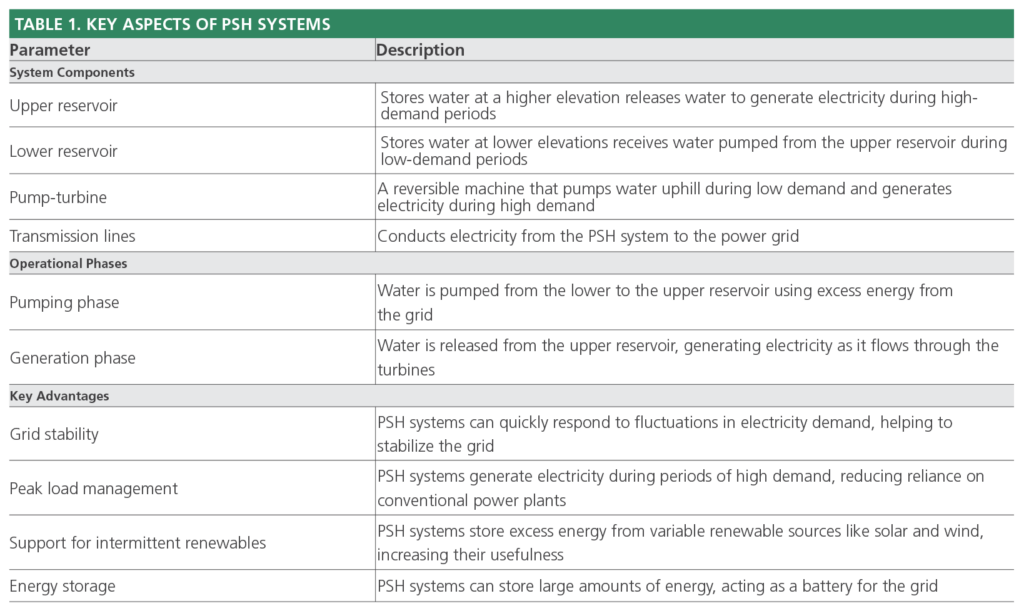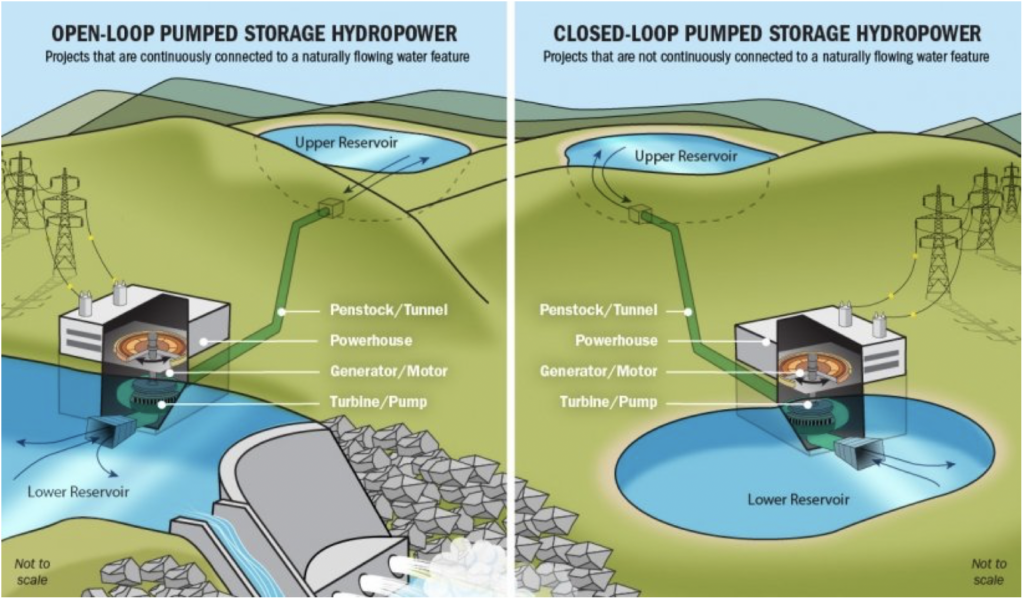Why is pumped storage hydropower an important technology? One word: Energy.
Pumped storage hydropower (PSH) is a sustainable and reliable energy storage solution (1). PSH technology harnesses the power of water and gravity to store and generate electricity, providing a reliable power source when needed (2). This flexible and efficient technology has proven to be a vital asset in energy grids worldwide, particularly as the adoption of intermittent renewable energy sources, such as solar and wind power, continues to rise (3). PSH is essential in fostering a sustainable energy future by offering grid stability, peak load management, and renewable energy integration (4).
In recent years, geosynthetics have been introduced to enhance the design, construction, and performance of PSH systems (5). Geosynthetics, (a range of synthetic materials used in civil engineering, environmental, and geotechnical applications) can potentially improve the efficiency, sustainability, and durability of PSH projects (6). By addressing challenges related to erosion control, slope stabilization, and seepage control, geosynthetics can contribute to the longevity and success of these crucial energy storage facilities.
This article discusses the integration of geosynthetics in PSH systems, highlighting their benefits. An overview of PSH technology, including its components and operation, is provided, followed by a detailed discussion of the types and uses of geosynthetics. The future implications and challenges of combining these technologies are also addressed, emphasizing the need for continued investment and research in sustainable energy storage solutions.
Pumped Storage Hydropower Systems
Pumped storage hydropower is currently the top power grid storage technology, contributing over 90% of utility-scale power storage. These systems function by storing and generating electricity using upper and lower reservoirs (See Figure 1). During periods of low electricity demand, excess energy from the grid can be used to pump water from the lower reservoir to the upper reservoir (7). When electricity demand is high, water from the upper reservoir is released, flowing back down to the lower reservoir and passing through turbines to generate electricity (8). A summary of the key aspects of PSH systems can be seen in Table 1.
Currently, PSH is the only energy storage technology implemented at a gigawatt level in the United States and internationally. Within the United States, there are more than 40 sites with a combined deployment of over 20 GW, and individual installations vary in capacity from under 50 MW to up to 2,100 MW (2). Many sites can store energy for over 10 hours, making them valuable for load-balancing. In addition to this, PSH is utilized for ancillary services. PSH uses conventional pumps and turbines and requires significant land and water for the upper and lower reservoirs. These plants can achieve round-trip efficiencies surpassing 75%; some have discharge capacities exceeding 20 hours (2).
Geosynthetics in PSH Systems
Geosynthetics are synthetic materials used in civil engineering, environmental, and geotechnical applications (9, 10). They include geotextiles, geomembranes, geogrids, and geocells, each with unique properties and functions (11). Various geosynthetic materials can be used, each with advantages and benefits (12).
In PSH systems, geosynthetics mitigate erosion and assist with slope stabilization and seepage control, Figure 2, (5). Erosion control is essential in maintaining the integrity of the PSH system’s infrastructure. Slope stabilization is another critical aspect of PSH system design, as unstable slopes can lead to catastrophic consequences. Geotextiles, for example, can protect slopes and embankments from water-induced erosion, reducing the risk of failure and extending the system’s lifespan (13). Additionally, geogrids and geocells can reinforce slopes, providing added stability and preventing landslides (14).
Seepage control is vital in PSH systems, as water leakage can compromise the efficiency of the energy storage process. Geomembranes, which are essentially impermeable synthetic liners, can be used to line reservoirs and prevent water loss (15). This not only maintains the system’s efficiency but also helps protect the surrounding environment from potential contamination.
Future Implications
With over 50 GW of PSH in the U.S. development pipeline, this is the perfect opportunity to implement technologies that ensure these new infrastructure projects provide a high return on their investment. Integrating geosynthetics in PSH systems presents numerous opportunities for improvement in efficiency, sustainability, and durability. Designing for long-term success can help sway public opinion and support states adopting energy storage targets.
Additionally, geosynthetics and other engineering plastics can help ensure the success of fast-track projects such as closed-loop PSH that may not require as much time for approval by the Federal Energy Regulatory Commission (FERC). Closed-loop systems do not touch naturally flowing water and can be designed from the ground up for energy storage purposes – such as using seawater instead of valuable freshwater reservoirs.
As investment in PSH increases, engineers will look to leverage existing technologies during research and development to create cost-effective and efficient systems. More in-depth studies on the long-term performance of geosynthetics and engineering plastics in PSH systems will provide valuable insights into best practices for novel designs.
Conclusion
Pumped storage hydropower is essential for sustainable and reliable energy storage, and the integration of geosynthetics in PSH systems offers significant advantages for longevity, efficiency, and return on investments. To summarize:
- Geosynthetics can help to reduce maintenance costs, extend the lifespan of PSH systems, and maintain their structural integrity by providing erosion control, slope stabilization, and seepage control.
- Geosynthetics can minimize the environmental impact of PSH projects by protecting surrounding ecosystems from potential contamination, preserving natural resources, and reducing land requirements for reservoir construction.
- Embracing the combination of PSH and geosynthetics plays a key role in addressing global energy challenges, supporting the integration of renewable energy sources, and promoting a more secure and environmentally responsible energy infrastructure.




Geosynthetics can help to reduce maintenance costs, extend the lifespan of pumped storage hydropower systems, and maintain their structural integrity by providing erosion control, slope stabilization, and seepage control.
AGRU also manufactures HDPE solid-walled pressure pipes up to OD 3500 mm and concrete protective liners, which also be incorporated into the design of efficient PSH systems.
Team up with AGRU to find the best solution for your project.
Contact Us
References
(1) A. Harby et al. “Pumped storage hydropower.” Transition to renewable energy systems. 2013.
(2) P. Denholm et al. “Role of energy storage with renewable electricity generation (No. NREL/TP-6A2-47187).” National Renewable Energy Lab.(NREL). Golden. CO (United States). 2010.
(3) H. Zsiborács et al. “Feasibility of the green energy production by hybrid solar+ hydro power system in Europe and similar climate areas.” Electronics. 2019.
(4) A. Botterud et al. “Pumped storage hydropower: benefits for grid reliability and integration of variable renewable energy (No. ANL/DIS-14/10).” Argonne National Lab.(ANL). Argonne. IL (United States). 2014.
(5) Z. Glasnovic and K. Margeta. “Revitalization of hydro energy: a new approach for storing solar energy.” Solar Energy Storage. 2015.
(6) M. Kashiwayanagi. “Performance of Geosynthetic rubber-sheet facing for the upper pond of seawater pumped storage hydropower plant..” ICOLD. Barcelona. 2006.
(7) J. S. Anagnostopoulos and D. E. Papantonis. “Pumping station design for a pumped-storage wind-hydro power plant.” Energy Conversion and Management. 2007.
(8) “Pumped Storage Hydropower.” Office of Energy Efficiency & Renewable Energy.
(9) B. R. Christopher. “Cost savings by using geosynthetics in the construction of civil works projects.” in 10th International Conference on Geosynthetics. Berlin. Germany. 2014.
(10) N. Touze-Foltz et al. “Geoenvironmental applications of geosynthetics.” Keynote Lecture. Proceedings Eurogeo. 2008.
(11) N. Touze. “Healing the world: a geosynthetics solution.” Geosynthetics International. vol. 28. no. 1. pp. 1-31. 2021.
(12) N. Dixon. “Geosynthetics: protecting the environment.” 2003.
(13) E. Palmeira. “Embankments.” in Handbook of Geosynthetic Engineering. ICE Publishing. 2012.
(14) S. K. Shukla et al. “Slopes-stabilization.” in Handbook of Geosynthetic Engineering. second edition. ICE Publishing. 2012.
(15) D. Cazzuffi et al. “Geosynthetic barriers systems for dams.” in 9th International Conference on geosynthetics. 2010.
